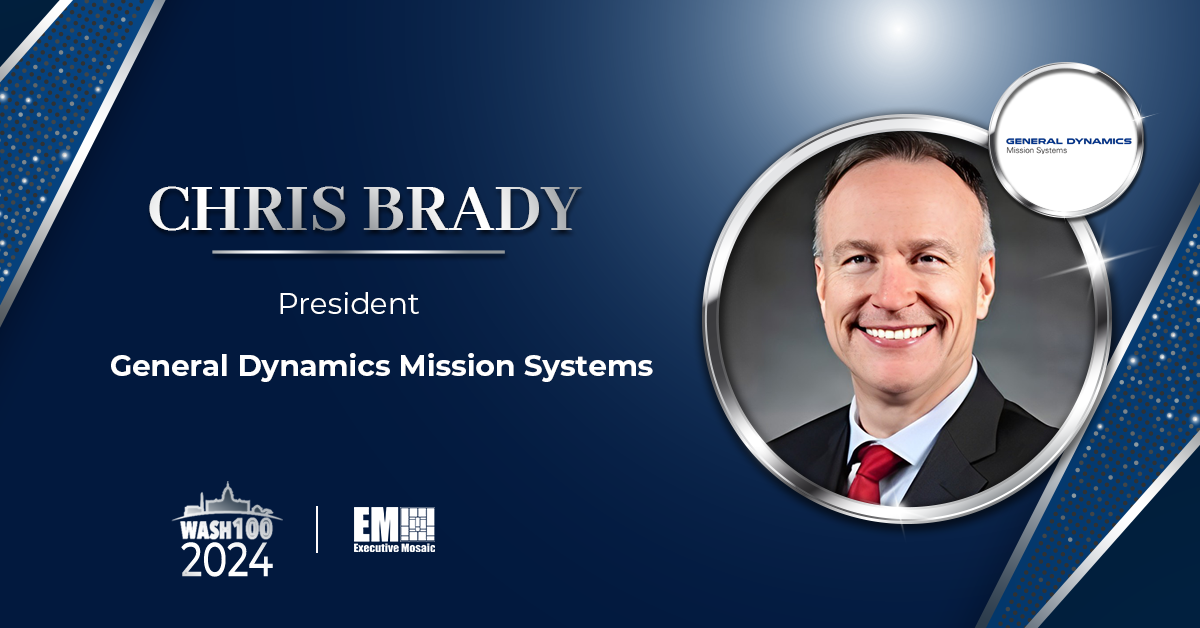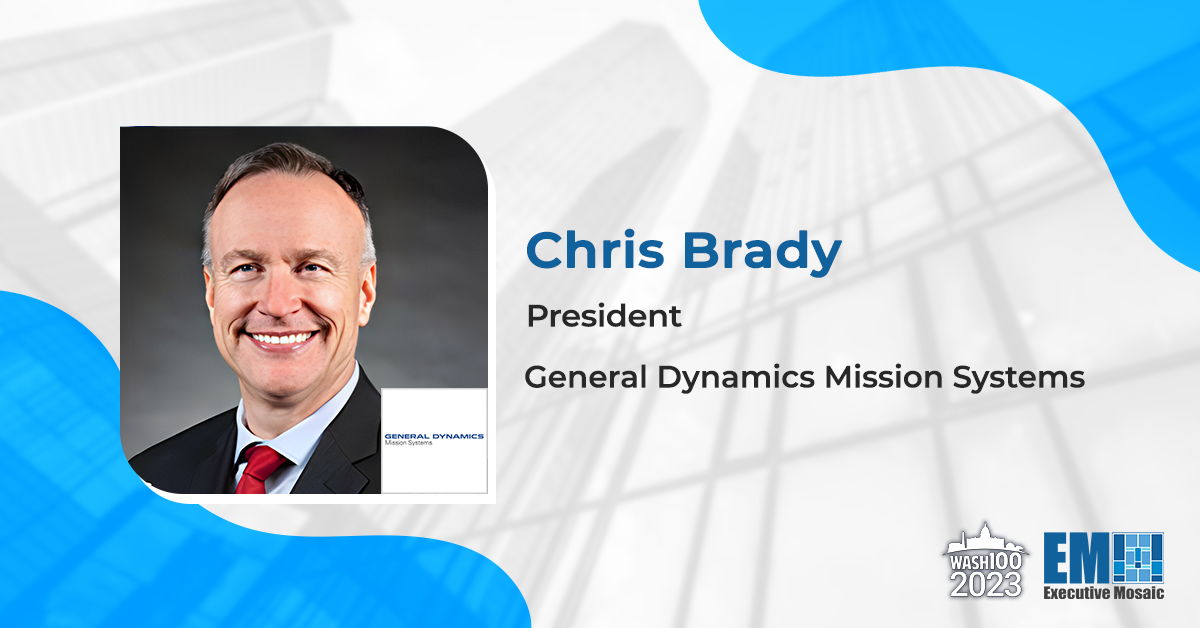Chris Brady, president of General Dynamics Mission Systems (GDMS) as well as a three-time Wash100 Award winner, recently spoke with GovCon Wire regarding the impact of the work GDMS is doing to support its customers in the development of UUV systems, space assets, unmanned vehicles and a lot more.
In addition, Brady also discussed recent contract awards to expand the company into the space market, the challenges of addressing drone and cyber threats for the U.S. and creating work opportunities for our nation’s veterans to contribute to the federal landscape during the latest Executive Spotlight interview.
“General Dynamics Mission Systems brings it all together and creates the solutions that must address all of those considerations. It’s really challenging engineering work, but that’s what also makes it fun. It’s very exciting stuff and it’s supporting the most important missions for our country. I’d invite anyone to come join us to have fun with great smart people and address the biggest challenges.”
You can read the full Executive Spotlight interview with Chris Brady below:
GovCon Wire: When we last spoke in August, we talked about the impact of Unmanned Underwater Vehicles (UUV) systems, unmanned vehicles, space assets and more on General Dynamic Mission Systems’ business and the capabilities of your customers. What can you tell us about the updates and advancements you’ve made with your customers since?
Chris Brady: “Autonomy is becoming an increasingly critical capability. Until now, it has mostly been used in the intelligence-gathering context. It’s rarely been spoken of for warfighting or strategic strikes. I think we’re now reaching a point where autonomy will become ingrained with how platforms operate across all domains – land, sea, air, space and cyber.
I think autonomy can be categorized into three tiers of capability and complexity, with the first tier including ‘the basics.’ For example, self-driving autonomy allows a vehicle or vessel to react to obstacles and travel across a space in real-time without hitting anything.
We are seeing that capability grow exponentially through several car manufacturers. The technology is solid and getting better day by day. That basic autonomy has significant applications in the manufacturing and defense spaces as well.
The second tier is based around applying autonomy to what you’d consider to be the ‘driver’ of the vehicle, or the brains of the process. This involves adapting autonomy to not only react to obstacles, but also to make complex decisions regarding what actions are needed to carry the mission through to success.
The third tier deals with that complex decision-making process, but in groups, so that you can have swarms of autonomous platforms collaborating to make decisions together. Should some platforms be lost during the battle, those remaining in the swarm account for the loss and can continue the mission. There’s no central place to have a sole decision maker.
If you think about these three tiers of autonomous capability for General Dynamics Mission Systems, we’re doing a little bit of the first in the context of our unmanned underwater vehicles.
For example, we have the ability to tailor our Bluefin Robotics UUVs for a variety of military and civilian missions through customizing the vehicle’s suite of sensors. We’ve also developed nine- and 12-inch diameter vessels with similar capabilities for Australia. We continue to refine and enhance our Knifefish platform as well.
We’re definitely focusing on expanding our UUV autonomy capabilities. In August, we opened our UUV Manufacturing and Assembly Center of Excellence in Taunton, Massachusetts. This facility will allow us to provide manufacturing, assembly, integrations and testing capabilities for our Knifefish and Bluefin programs.
As we look at further applying autonomy to the second and third tiers, we know the tools and techniques necessary for a vessel to decide how, when and why to dive below the surface. Is it to avoid obstacles? Do we just want to reach the seafloor and explore, etc? Swarming isn’t as essential in the undersea domain just yet because, obviously, the communications are limited undersea between vessel teams.
We recently won another contract in the undersea domain for a system called ‘Hammerhead.’ It’s a prototype of a Navy submarine mine system that must be highly secure because it has some very powerful munitions attached. However, it will also be able to react to specific threats wherever it’s deployed.
Obviously, we have a lot of things happening in the undersea domain for autonomy. We also have some key positions in unmanned surface vessels. We’ve recently won a couple of roles on the Overlord Unmanned Surface Vessel and the Expeditionary Fast Transport (EPF) that will position us very well for the integration of intelligence and electronics on those vessels, as well as others in the future.
In the air domain, we have been awarded some key positions on a few autonomous platforms that are in prototype for the U.S. Air Force. They will evolve over time into a purely autonomous aircraft as well. We also have some positions to do more of the mission and electronics integration on those platforms.
For the ground domain, we have been working with General Dynamics Land Systems, our sister company, on the Optionally Manned Fighting Vehicle that allows the U.S. Army to have some autonomous mission-control capabilities, including assured position navigation and timing.
General Dynamics Mission Systems is actively engaged in developing smarter solutions for our customers across all of these domains. We have put ourselves into some pretty good early positions while the government determines how it wants to best leverage autonomy and the platforms they want to use for it.”
GovCon Wire: What can you tell us about the recent $229M Next Generation Load Device-Medium contract and General Dynamics Mission Systems’ expansion into the space market?
Chris Brady: “We’re very proud of that effort. First and foremost, these cryptological devices must be trusted to carry very sensitive encryption keys to protect the transmission of critical data to and from our frontline forces, the flight line, a carrier deck or other platforms at the fighting edge.
To develop this innovative technology, our engineers enhanced some capabilities we already had in very small form factors like our nano encryption devices (which are already handheld) and applied some of the same trusted technology to drive down the cost and assure the security of this solution.
Regarding the space domain, General Dynamics Mission Systems has had a strong presence in the space market for more than 60 years, enabling more than 400 missions of discovery and counting. We’ve provided critical communication links onboard every deep space probe and every Mars rover and lander.
Our specialized beryllium machining team created the 18 mirrors (and three spares) on the recently launched James Webb Space Telescope, which entered service in February. We love this unique work our company is bringing to space exploration.
Beryllium is a very lightweight and durable substance for missions like this with extreme hot and cold temperatures. It’s ideal for this particular application, which requires incredible precision in how the mirrors are properly formed and stay in position in extreme environments. In addition to the mirrors, our team has also provided a number of engineering services to support pre-launch, launch and post-launch success.
We’re very excited to see some of the first images coming back from the telescope and can’t wait for them to get all of those mirrors aligned to see some amazing things from the early days of the universe.
Going back to the topic of autonomy, we have a big presence in space which has always been a natural autonomous venture. To start with, we have a long history of providing a wide variety of sensors for special missions, whether for NASA missions or high-consequence missions for our government and military customers.
We also provide assured position navigation and timing resources for our space customers, giving satellites pinpoint direction. As a result, we have GPS receivers that are unique and hardened for those challenging and high stakes mission requirements. We also develop and provide satellite ground systems as well as control satellites to communicate with them.
On top of that, we apply our cybersecurity expertise to develop a growing portion of the encryption involved in the communication with and computing on board spacecraft.
We’re extremely proud of our extraordinary space heritage and it’s one that is expanding and growing at an exceptional rate. We’ve introduced something called ‘Space Module Common Crypto,’ which is a set of capabilities you can mix and match to adapt to a wide variety of missions and still be very cost effective.
As you can see, we are locked into the space market and it’s only going to grow in size and importance from here.”
GovCon Wire: As major advancements and applications in drone technology continue to be as strong a potential threat to our national security as cyber in the near future, why is it absolutely critical for all organizations to not forget and secure their assets from drone threats?
Chris Brady: “We continue to work closely with our partners around drone technology. The drone is one of those offerings that I would describe as the ‘innovator’s dilemma.’
If you read The Innovator’s Dilemma, you will learn that sometimes there are lower cost solutions that are suitable for simpler applications that grow in sophistication to knock off even the most high-end and expensive applications for a particular solution. We are working on simple, non-kinetic ways to protect our critical infrastructure from drone incursions and attacks.
General Dynamics Mission Systems hasn’t had a big enough window to bring counter-drone technology to the military just yet. However, there is tremendous opportunity to provide counter-UAS capabilities to some civilian governments as well as to private commercial entities.
As we continue to develop these capabilities, we’ll look at this being a cloud-based solution that scales very well at a low cost. There are thousands of critical infrastructure and sensitive facilities around the continental U.S. that I think will require a significant amount of counter-UAS support. Our focus is to bring that same capability to the military to support appropriate customer missions.”
GovCon Wire: General Dynamics Mission Systems announced that it had received six different awards for the work General Dynamics Mission Systems does with and supporting our veterans! What can you tell us about recruiting and driving work opportunities for our veterans and former warfighters who have a wealth of experience to be able to contribute to the federal landscape?
“We love our veterans. We’re proud to have a workforce of almost 20 percent military veterans and we have a focused strategy on programs that allow us to access the top military talent.
At General Dynamics Mission Systems, we try to be different in the sense that we’ve created a dedicated website to support our transitioning service members and veterans, as well as currently serving Reserve and National Guard personnel, military spouses and caregivers. We offer a skills translation tool that veteran candidates can use to understand how their skills can apply to our world. We also offer one-on-one assistance.
As a company, we do everything we can to ensure our veterans are prepared to apply and interview for a position with us. While the private sector is not the same as the military, the characteristics and leadership traits that service members bring to our company is immeasurable.
Our military outreach teams foster relationships with a number of Veterans Service Organizations that have similar missions, and not just with service members, but also military spouses. Our employees are also very active in volunteerism to further support our veterans through foundations like Sentinels of Freedom, the Wounded Warrior Project and others.
We’re really focused on transitioning those service members into a rewarding career. It’s also so important to have them in our business. They understand the mission from the intellectual perspective, but especially in their hearts. They understand how important it is to get this right for those who are doing some of the toughest jobs in the hardest places. We couldn’t do better than to hire and learn from our great veterans.”
GovCon Wire: As you work to continue to drive new advancements, solutions and growth for General Dynamics Mission Systems, what is your growth strategy for the company and what do you hope to accomplish as 2022 moves forward and beyond?
Chris Brady: “As we discussed, autonomy is obviously going to become critically important across the board. Another significant growth opportunity is in the realm of nuclear command and control. We have been a longtime provider of fire control systems for the strategic programs in the U.S. Navy.
We’ve also had a significant role in ship-board guidance systems needed to support their missions. Now that the service is chartered to take on conventional prompt strike and hypersonic capability, we’re doing some similar functions in those domains as well.
Over the last year and a half, we have gained a position with our prime Northrop Grumman to work on the ground-based strategic deterrent. This is the Air Force’s major modification of their nuclear deterrence.
Recently, we’ve gained a few more contracts to improve the networking and security of nuclear command and control. It’s obviously an area of great importance when you consider the peace dividend that the whole world has gained since the presence of nuclear weapons, and we’re here to continue supporting our military and their missions.
The last thing I’d add is, as always, General Dynamics Missions Systems aims to bring in and retain the very best people. We have a large team of extremely talented and smart people who can anticipate and innovate around our customers’ evolving needs and who can manipulate a wide variety of capabilities that range from cyber to special materials and so much more. The areas of application range from undersea to electronic warfare to special physics and space.
There’s a lot of great stuff we do. General Dynamics Mission Systems brings it all together and creates the solutions that must address all of those considerations. It’s really challenging engineering work, but that’s what also makes it fun. It’s very exciting stuff and it’s supporting the most important missions for our country. I’d invite anyone to come join us to have fun with great smart people and address the biggest challenges.”









